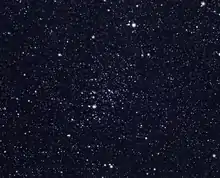NGC 4349
NGC 4349 is an open cluster in the constellation Crux. It was discovered by James Dunlop in 1826. It is located approximately 7,000 light years away from Earth.
| NGC 4349 | |
|---|---|
 NGC 4349 | |
| Observation data (J2000 epoch) | |
| Constellation | Crux |
| Right ascension | 12h 24m 08s[1] |
| Declination | −61° 52′ 18″[1] |
| Distance | 7,090 ly (2,176 pc[2]) |
| Apparent magnitude (V) | 7.4 [1] |
| Apparent dimensions (V) | 12'[3] |
| Physical characteristics | |
| Mass | 4,400[4] M☉ |
| Estimated age | 250 million years[3] |
| Other designations | Cr 255, Mel 110 |
Characteristics
There are 390 probable member stars within the angular radius of the cluster and 129 within the central part of the cluster. The tidal radius of the cluster is 17.8 - 22.8 parsecs (58 - 75 light years) and represents the average outer limit of NGC 4349, beyond which a star is unlikely to remain gravitationally bound to the cluster core.[4] One blue straggler has been detected in the cluster.[5] There are four Cepheid variables at the direction of the cluster, among which R and T Crucis which, however, are not members of the cluster.[6] R Crucis lies 16 arcminutes from the centre of the open cluster NGC 4349, which is beyond the outer limit of the cluster, and is estimated to be nearly 1 kpc closer to Earth than the cluster.[7] The cluster has subsolar metallicity (−0.12 ± 0.06).[8]
A brown dwarf with minimum mass 19,8 times larger the one of Jupiter has been detected to orbit around star no. 127 (vmag. 10,88 and with mass 3.9 M☉) every 678 days. At the time of discovery, star NGC 4349 No. 127 was the heaviest star with an accurate mass determination around which a substellar companion had been detected, and also one of the youngest systems known.[9]
References
- "NGC 4349". SIMBAD. Centre de données astronomiques de Strasbourg. Retrieved 2017-08-19.
- WEBDA page for open cluster NGC 4349
- Kharchenko, N. V.; Piskunov, A. E.; Schilbach, E.; Röser, S.; Scholz, R.-D. (3 October 2013). "Global survey of star clusters in the Milky Way". Astronomy & Astrophysics. 558: A53. arXiv:1308.5822. Bibcode:2013A&A...558A..53K. doi:10.1051/0004-6361/201322302.
- Piskunov, A. E.; Schilbach, E.; Kharchenko, N. V.; Röser, S.; Scholz, R.-D. (6 November 2007). "Tidal radii and masses of open clusters". Astronomy & Astrophysics. 477 (1): 165–172. Bibcode:2008A&A...477..165P. doi:10.1051/0004-6361:20078525.
- Ahumada, J. A.; Lapasset, E. (20 November 2006). "New catalogue of blue stragglers in open clusters". Astronomy & Astrophysics. 463 (2): 789–797. Bibcode:2007A&A...463..789A. doi:10.1051/0004-6361:20054590.
- Anderson, Richard I.; Eyer, Laurent; Mowlavi, Nami (July 2013). "Cepheids in open clusters: an 8D all-sky census". Monthly Notices of the Royal Astronomical Society. 434 (3): 2238–2261. arXiv:1212.5119. Bibcode:2013MNRAS.434.2238A. doi:10.1093/mnras/stt1160.
- Chen, X.; de Grijs, R.; Deng, L. (19 November 2014). "A search for open cluster Cepheids in the Galactic plane". Monthly Notices of the Royal Astronomical Society. 446 (2): 1268–1282. arXiv:1410.4489. Bibcode:2015MNRAS.446.1268C. doi:10.1093/mnras/stu2165.
- Santos, N. C.; Lovis, C.; Melendez, J.; Montalto, M.; Naef, D.; Pace, G. (17 February 2012). "Metallicities for six nearby open clusters from high-resolution spectra of giant stars". Astronomy & Astrophysics. 538: A151. arXiv:1201.1108. Bibcode:2012A&A...538A.151S. doi:10.1051/0004-6361/201118276.
- Lovis, C.; Mayor, M. (26 June 2007). "Planets around evolved intermediate-mass stars". Astronomy & Astrophysics. 472 (2): 657–664. arXiv:0706.2174. Bibcode:2007A&A...472..657L. doi:10.1051/0004-6361:20077375.
External links
| Wikimedia Commons has media related to NGC 4349. |
- NGC 4349 on WikiSky: DSS2, SDSS, GALEX, IRAS, Hydrogen α, X-Ray, Astrophoto, Sky Map, Articles and images